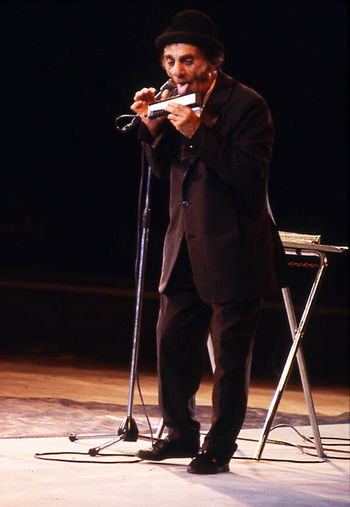George Carl
From Circopedia
Juggler, Acrobat, Equestrian, Clown
By Dominique Jando
George Carl (1916-2000) is a true comedy legend that remains an inspiration to anyone interested in pursuing a career in physical comedy—and he was indeed one of the greatest clowns/comedians of the second half of the twentieth century.
He was born Georgio Carlotti on May 7, 1916, in Ohio, in the United States, in a family of Italian origins. While still in his teens, he left the family’s farm and joined a traveling circus. There he learned an array of traditional circus disciplines and began his performing career as a juggler, then continued as a tumbler, an acrobat on trampoline, and a teeterboardA seesaw made of wood, or fiberglass poles tied together, which is used to propel acrobats in the air. acrobat (with the Tom Mix Circus), and even joined for a time the equestrian troupe of the legendary Poodles Hanneford.
In the early 1950s he created an acrobatic act with his wife, in which they were joined by two of their three children, and with which they performed notably with the Kelly-Miller Circus in the United States. George Carl, as he became known in the business, was then in his forties, and he started working in variety shows, which were more comfortable (and lucrative) than the circus.
Carl had a knack for visual comedy, which was less taxing on his aging body than pure acrobatics, and he turned his work to comedy; his manic movements, which included some hat juggling, his fights with inanimate objects (notably a microphone stand) that seemed to conspire against him) and even with his own body, became his trademark. In the early 1960s, his had become a solo act.
It was a perfect act for variety stages and nightclubs, as well as for television shows: he was to be featured in many of them, from late-night American shows (notably on the Johnny Carson show in 1986) to television specials in the U.S. and abroad. After the death of his wife, he left the United States and settled in Europe where he secured long-time contracts with the legendary Lido of Paris, and for seven years, at Paris’s famed Crazy Horse Saloon—then a unique temple of both beautiful women and superlative visual comedians.
The Clown Who Sent Royalty in Stitches
In 1974, George Carl brought down the house at the Royal Variety performance attended by the Queen Mother at the London Palladium (sharing the bill with Joséphine Baker and Perry Como, among others); he performed at another Royal Variety performance in 1987, this time in front of Queen Elizabeth II (with a spectacular all-star cast that included Shirley Bassey and Tom Jones).
The highest point of his career occurred in 1979, when he participated in the fifth International Circus Festival of Monte Carlo. The festival had then the reputation of being a "clown graveyard": The configuration of its huge big topThe circus tent. America: The main tent of a traveling circus, where the show is performed, as opposed to the other tops. (French, Russian: Chapiteau) was not helping comedy other than of the broad slapstick variety—not really the style of great European clowns, whose work was generally more refined. Everyone familiar with his act wondered how Carl, used as he was to the relative intimacy of nightclubs, would survive it.
Yet, George Carl’s frantic visual comedy, as minimalist as it often seemed, proved irresistible up to the very last rows of the elongated tent, and he left the ring with Prince Rainier III and the jury in stitches: He was unanimously awarded the coveted Gold Clown award—the circus equivalent of the film industry’s Oscars®. Taking his bow at the end of his performance on the final Gala night, the sixty-three years old comedian surprised everyone when he turned an impeccable somersault on the spot…
In 1981, he was featured on Ken Dodd’s Christmas Laughter Show on the BBC, and again on the very popular Paul Daniels Magic Show in 1984. Meanwhile, in 1983, he returned to the ring and toured Switzerland with Circus Knie. In 1988, he appeared in the short-lived revival of the Smothers Brothers Comedy Hour on CBS Television, where he entangled himself in his microphone cord and his suspenders with Tommy Smothers.
By the beginning of the next decade, George Carl began to suffer from the early symptoms of Alzheimer. He decided to retire from performing and settled in Las Vegas. His son Tony tried to revive his father’s act, but as it generally happens, George Carl’s unique personality couldn’t be duplicated. Carl made his last appearance as the retired comedian “Thomas Parker” in Peter Chelsom’s film Funny Bones (1995), starring Jerry Lewis—a movie that has since become a cult film around the world for comedy fans and students.
George Carl died of cancer in his home in Las Vegas on January 1, 2000, just as a new century began—a century that, luckily, can still admire and laugh at George Carl's comedic genius thanks to the many television shows (and a film) in which he appeared.
See Also
- Video: George Carl, "Acrobat" entrée, on the Ed Sullivan Show (1962)
- Video: George Carl, clown entrée, at the Royal Circus in Stockholm (1977)
- Video: Goerges Carl, clown entrée, at the International Circus Festival of Monte Carlo (1979)
- Video: George Carl, clown entrée, on BBC's The Paul Daniels Magic Show (1984)
- Video: George Carl, clown entrée, at the Royal Variety Performance in London (1987)
- Video: George Carl, clown entrée, on CBS TV's The Smothers Brothers Comedy Hour (1988)

